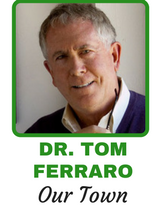Many great works of literature are about moving and traveling and venturing out into the wilderness. Many of the great masterpieces are about leaving hometown.
In “Search of the Holy Grail,” “Moby Dick,” “Robinson Crusoe,” “Les Miserables,” “Don Quixote,” “Call of the Wild,” “Huckleberry Finn,” “Wizard of Oz,” “Pinocchio” and “Treasure Island” are all about leaving home in search of something better.
And in the end the hero rarely finds anything better and must admit as Dorothy did “There’s no place like home”.
There are just a few great works of literature and cinema that try to come to terms with town life and what it has to offer.
The most famous of all is “Our Town” where Thornton Wilder depicts the beauty of a simple town and how rare it is for people to value it.
Sartre’s “Nausea” is one of the great existential masterworks and although it is mostly about anomie it also has a wonderful scene where he describes how the town comes alive on a Sunday morning where people go to church services.
Goethe’s “Dr. Faustus” has a similar scene where the despairing doctor takes a stroll on the Sunday morning around town and is greeted by all of his admirers.
Sadly Dr. Faustus fails to appreciate this life he lives and winds up making a pact with the devil who at first looks like a friendly dog.
Thomas Merton is the writer who began his life on Long Island and wound up as a monk. “The Seven Storey Mountain” is his well-known memoir which describes his conversion to God during a touching scene where he looks down on his hometown on a Sunday morning and receives a revelation.
James Joyce would also describe the poignancy of his hometown of Dublin on a lazy Sunday morning.
Finally what may be the best film ever made was the Ozu masterwork Tokyo Story (1953) which was that overwhelmingly sweet film about how a family fragments apart as the children leave their hometown in search of work elsewhere.
Alas since today is Sunday and I have some free time I thought I would head down to Main Street here in Williston Park and observe what this sweet town looks like on a Sunday morning. I doubt it would be much like Joyce’s Dublin or Proust’s Mesiglise Way or Barcelona’s Las Ramblas but one never knows where inspiration lurks.
As I walked past Solomon Schechter High School along Cross Street the first thing I notice is a father and son performing one of the most cherished of family rituals, a boy learning to ride a bike.
There was the father protectively running along beside his son who was bravely pedaling with the hope that he would not fall and cut apart his knees. If this is not a pure slice of American town life I don’t know what is.
I proceeded up to Hillside and headed north with St Aidan’s Church as my goal. I originally planned on staking out a place on the lawn of the town hall where I would watch the town’s people enter the church and wax poetic about all that.
However, the combination of oppressive heat, flat terrain, lack of focus and rushing traffic prevented that from happening. Instead, I merely snapped a quick photo of the front of the church and made my way across Hillside Avenue without getting run over by speeding traffic.
I then entered the church and was happy to feel how cool it was to be inside. We were between masses so not much action was unfolding within. I did run into a friend who was one of the ushers in church and we chatted briefly.
I made sure I used the holy water to bless myself as I left.
In the end, I think I discovered what I needed to see. Wilder and Proust and Sartre and Joyce all had a chance to enjoy town life during a simpler time.
People traveled then but not as often, not as far and not as frequently. And they certainly did not live in a town dominated by cars. so they had ample opportunity to witness one of life’s great rituals, which was walking through town on a Sunday morning. Now what we have is a car culture with folks speeding along and getting angry as they do so.
There is an urban movement afoot in America called ‘walkable towns’.
Some towns like Carmel by the Sea are used as models for this movement. Seaside, Florida and the Pearl District in Portland, Oregon are two areas where this has happened. I think the old section of Roslyn is a walkable town and so is the old section of Stony Brook. These are places where the human aspect of a town is emphasized and protected and where the car aspect is held in abeyance.
Just like Mr. Adell running alongside his son to protect him, towns desperately need some clever urban planners to somehow protect us from the encroachment of cars and pavement and big box stores and traffic lights.
And if and when that happens what we will see is that far fewer people will have a desire to run from their town in the questionable hope that a better life will be found elsewhere.




